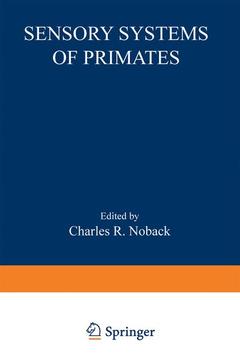Sensory Systems of Primates, Softcover reprint of the original 1st ed. 1978 Advances in Primatology Series
Langue : Anglais
Coordonnateur : Noback Charles

Primates are avid explorers that utilize a variety of sensory clues from the environment. The special senses of olfaction, audition, and particu larly vision are thus of paramount significance in the evolution and adaptive radiation of the primates. It was with this in mind that this volume was planned to present some recent research advances. The chapter on olfactory communication among primates affords new insights concerning a sense which, though primatologists have generally relegated it to a minor role, is of considerable significance in the primates. The chapters on the auditory system are organized to stress three aspects: the receptive organ, the neural pathways, and the role of audition in primate communication. The visual system, the dominant special sense of primates, is analyzed with respect to two regions of the brain, namely, the organization of the superior colliculus and the visual cortex. Finally, the chapter on endocasts in the study of primate brain evolution will alert neurobiologists to the relevant information that can be unearthed from fossils embedded in the terrane. I wish to thank the publishers, and especially Miss Phyllis Straw and Mr. Seymour Weingarten, for their support, patience, guidance, and professional assistance.
1. Structural Organization and Communicatory Functions of Olfaction in Nonhuman Primates.- I. Introduction.- II. Structural Organization.- III. Communicatory Functions of Olfactory Signals.- IV. References.- 2. Physical and Physiological Principles Controlling Auditory Sensitivity in Primates.- I. Introduction.- II. The Ear as an Early Warning Device.- III. Sensitivity of Detection.- IV. Directional Reception of Sound.- V. Brownian Noise.- VI. Improvement in Sensitivity of Detection by Reduction of Noise.- VII. The Effect of Narrow-Band Filters on Brownian Noise.- VIII. Detection of Signals.- IX. Multiple Sources of Noise.- X. Concluding Remarks.- XI. References.- 3. The Anatomical Organization of the Primate Auditory Pathways.- I. Introduction.- II. Morphological Aspects of the Auditory Pathway.- III. The Course and Distribution of Primary Auditory Fibers.- IV. Ascending Fiber Systems in the Central Nervous System.- V. Other Connections.- VI. References.- 4. Vocal Communication in Primates.- I. Introduction.- II. The Auditory Signal.- III. Perception of Vocalizations.- IV. Conclusions and Summary.- V. References.- 5. Structural and Functional Aspects of the Superior Colliculus in Primates.- I. Introduction.- II. Anatomical Studies.- III. Physiological Studies.- IV. Behavioral Studies.- V. Summary and Conclusion.- VI. References.- 6. Parallel Pathways Connecting the Primate Superior Colliculus with the Posterior Vermis: An Experimental Study Using Autoradiographic and Horseradish Peroxidase Tracing Methods.- I. Introduction.- II. Materials and Methods.- III. Results.- IV. Discussion.- V. References.- 7. The Organization of Visual Cortex in Primates.- I. Introduction.- II. The Visual Areas.- III. Connections.- IV. The Significance of Multiple Representations.- V. References.- 8. The Relevance of Endocasts for Studying Primate Brain Evolution.- I. Introduction.- II. Possible Lines of Evidence for Brain Evolution.- III. Qualitative and Quantitative Descriptions.- IV. Toward Fuller Morphometric Analyses.- V. Addendum.- VI. References.
Date de parution : 06-2012
Ouvrage de 208 p.
15.2x22.9 cm
Thème de Sensory Systems of Primates :
Mots-clés :
anatomy; brain; communication; cortex; evolution; information; nervous system; neurons; organization; perception; physiology; research; system
© 2024 LAVOISIER S.A.S.



